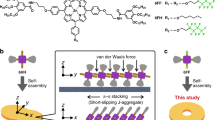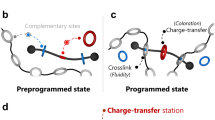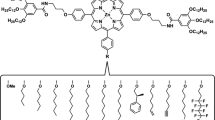Abstract
Various conventional reactions in polymer chemistry have been translated to the supramolecular domain, yet it has remained challenging to devise living supramolecular polymerization. To achieve this, self-organization occurring far from thermodynamic equilibrium—ubiquitously observed in nature—must take place. Prion infection is one example that can be observed in biological systems. Here, we present an ‘artificial infection’ process in which porphyrin-based monomers assemble into nanoparticles, and are then converted into nanofibres in the presence of an aliquot of the nanofibre, which acts as a ‘pathogen’. We have investigated the assembly phenomenon using isodesmic and cooperative models and found that it occurs through a delicate interplay of these two aggregation pathways. Using this understanding of the mechanism taking place, we have designed a living supramolecular polymerization of the porphyrin-based monomers. Despite the fact that the polymerization is non-covalent, the reaction kinetics are analogous to that of conventional chain growth polymerization, and the supramolecular polymers were synthesized with controlled length and narrow polydispersity.
This is a preview of subscription content, access via your institution
Access options
Subscribe to this journal
Receive 12 print issues and online access
$259.00 per year
only $21.58 per issue
Buy this article
- Purchase on Springer Link
- Instant access to full article PDF
Prices may be subject to local taxes which are calculated during checkout





Similar content being viewed by others
References
Brunsveld, L., Folmer, B. J. B., Meijer, E. W. & Sijbesma, R. P. Supramolecular polymers. Chem. Rev. 101, 4071–4097 (2001).
Aida, T., Meijer, E. W. & Stupp, S. I. Functional supramolecular polymers. Science 335, 813–817 (2012).
Hoeben, F. J. M., Jonkheijm, P., Meijer, E. W. & Schenning, A. P. H. J. About supramolecular assemblies of π-conjugated systems. Chem. Rev. 105, 1491–1546 (2005).
Elemans, J. A. A. W., van Hameren, R., Nolte, R. J. M. & Rowan, A. E. Molecular materials by self-assembly of porphyrins, phthalocyanines, and perylenes. Adv. Mater. 18, 1251–1266 (2006).
Wu, J., Pisula, W. & Müllen, K. Graphenes as potential material for electronics. Chem. Rev. 107, 718–747 (2007).
Ajayaghosh, A., Praveen, V. K. & Vijayakumar, C. Organogels as scaffolds for excitation energy transfer and light harvesting. Chem. Soc. Rev. 37, 109–122 (2008).
Rosen, B. M. et al. Dendron-mediated self-assembly, disassembly, and self-organization of complex systems. Chem. Rev. 109, 6275–6540 (2009).
Martin, R. B. Comparisons of indefinite self-association models. Chem. Rev. 96, 3043–3064 (1996).
Zhao, D. & Moore, J. S. Nucleation–elongation: a mechanism for cooperative supramolecular polymerization. Org. Biomol. Chem. 1, 3471–3491 (2003).
De Greef, T. F. A. et al. Supramolecular polymerization. Chem. Rev. 109, 5687–5754 (2009).
Chen, Z., Lohr, A., Saha-Möller, C. R. & Würthner, F. Self-assembled π-stacks of functional dyes in solution: structural and thermodynamic features. Chem. Soc. Rev. 38, 564–584 (2009).
Chen, Z. et al. Photoluminescence and conductivity of self-assembled π–π stacks of perylene bisimide dyes. Chem. Eur. J. 13, 436–449 (2007).
Smulders, M. M. J. et al. How to distinguish isodesmic from cooperative supramolecular polymerisation. Chem. Eur. J. 16, 362–367 (2010).
Jonkheijm, P., van der Schoot, P., Schenning, A. P. H. J. & Meijer, E. W. Probing the solvent-assisted nucleation pathway in chemical self-assembly. Science 313, 80–83 (2006).
Smulders, M. M. J., Schenning, A. P. H. J. & Meijer E. W. Insight into the mechanisms of cooperative self-assembly: the ‘sergeants-and-soldiers’ principle of chiral and achiral C3-symmetrical discotic triamides. J. Am. Chem. Soc. 130, 606–611 (2008).
Fernández, G., Stolte, M., Stepanenko, V. & Würthner, F. Cooperative supramolecular polymerization: comparison of different models applied on the self-assembly of bis(merocyanine) dyes. Chem. Eur. J. 19, 206–217 (2013).
Odian, G. Principles of Polymerization 4th edn (Wiley, 2004).
Khuong, K. S., Jones, W. H., Pryor, W. A. & Houk, K. N. The mechanism of the self-initiated thermal polymerization of styrene. Theoretical solution of a classic problem. J. Am. Chem. Soc. 127, 1265–1277 (2005).
Breslow, R. Biomimetic chemistry: biology as an inspiration. J. Biol. Chem. 284, 1337–1342 (2009).
Alper, T., Cramp, W. A., Haig, D. A. & Clarke, M. C. Does the agent of scrapie replicate without nucleic acid? Nature 214, 764–766 (1967).
Griffith, J. S. Self-replication and scrapie. Nature 215, 1043–1044 (1967).
Laurent, M. Prion diseases and the ‘protein only’ hypothesis: a theoretical dynamic study. Biochem. J. 318, 35–39 (1996).
Aguzzi, A. & Calella, A. M. Prions: protein aggregation and infectious diseases. Physiol. Rev. 89, 1105–1152 (2009).
Korevaar, P. A. et al. Pathway complexity in supramolecular polymerization. Nature 481, 492–496 (2012).
Van Hameren, R. et al. Macroscopic hierarchical surface patterning of porphyrin trimers via self-assembly and dewetting. Science 314, 1433–1436 (2006).
Helmich, F. et al. Dilution-induced self-assembly of porphyrin aggregates: a consequence of coupled equilibria. Angew. Chem. Int. Ed. 49, 3939–3942 (2010).
Shirakawa, M., Kawano, S., Fujita, N., Sada, K. & Shinkai, S. Hydrogen-bond-assisted control of H versus J aggregation mode of porphyrins stacks in an organogel system. J. Org. Chem. 68, 5037–5044 (2003).
Bachmann, P. A., Luisi, P. L. & Lang, J. Autocatalytic self-replicating micelles as models for prebiotic structures. Nature 357, 57–59 (1992).
Carnall, J. M. A. et al. Mechanosensitive self-replication driven by self-organization. Science 327, 1502–1506 (2010).
Cheng, P-N., Liu, C., Zhao, M., Eisenberg, D. & Nowick, J. S. Amyloid β-sheet mimics that antagonize protein aggregation and reduce amyloid toxicity. Nature Chem. 4, 927–933 (2012).
Baskakov, I. V., Legname, G., Baldwin, M. A., Prusiner, S. B. & Cohen, F. E. Pathway complexity of prion protein assembly into amyloid. J. Biol. Chem. 277, 21140–21148 (2002).
Baldwin, R. L. On-pathway versus off-pathway folding intermediates. Folding Des. 1, R1–lR8 (1996).
Stals, P. J. M. et al. Symmetry breaking in the self-assembly of partially fluorinated benzene-1,3,5-tricarboxamides. Angew. Chem. Int. Ed. 51, 11297–11301 (2012).
Lohr, A., Lysetska, M. & Würthner, F. Supramolecular stereomutation in kinetic and thermodynamic self-assembly of helical merocyanine dye nanorods. Angew. Chem. Int. Ed. 44, 5071–5074 (2005).
Lohr, A. & Würthner, F. Evolution of homochiral helical dye assemblies: involvement of autocatalysis in the ‘majority-rules’ effect. Angew. Chem. Int. Ed. 47, 1232–1236 (2008).
Powers, E. T. & Powers, D. L. Mechanisms of protein fibril formation: nucleated polymerization with competing off-pathway aggregation. Biophys. J. 94, 379–391 (2008).
Wang, X. et al. Cylindrical block copolymer micelles and co-micelles of controlled length and architecture. Science 317, 644–647 (2007).
Gädt, T. et al. Complex and hierarchical micelle architectures from diblock copolymers using living, crystallization-driven polymerizations. Nature Mater. 8, 144–150 (2009).
Gilroy, J. B. et al. Monodisperse cylindrical micelles by crystallization-driven living self-assembly. Nature Chem. 2, 566–570 (2010).
Qiu, H. et al. Tunable supermicelle architectures from the hierarchical self-assembly of amphiphilic cylindrical B–A–B triblock co-micelles. Angew. Chem. Int. Ed. 51, 11882–11885 (2012).
Rupar. P. A., Chabanne, L., Winnik, M. A. & Manners. I. Non-centrosymmetric cylindrical micelles by unidirectional growth. Science 337, 559–562 (2012).
Zhang, W. et al. Supramolecular linear heterojunction composed of graphite-like semiconducting nanotubular segments. Science 334, 340–343 (2011).
George, S. J. et al. Asymmetric noncovalent synthesis of self-assembled one-dimensional stacks by a chiral supramolecular auxiliary approach. J. Am. Chem. Soc. 134, 17789–17796 (2012).
Zhang, W., Jin, W., Fukushima, T., Ishii, N. & Aida, T. Dynamic or nondynamic? Helical trajectory in hexabenzocoronene nanotubes biased by a detachable chiral auxiliary. J. Am. Chem. Soc. 135, 114–117 (2013).
Shao, C., Stolte, M. & Würthner, F. Quadruple π stack of two perylene bisimide tweezers: a bimolecular complex with kinetic stability. Angew. Chem. Int. Ed. 52, 7482–7486 (2013).
Shao, C., Stolte, M. & Würthner, F. Backbone-directed perylene dye self-assembly into oligomer stacks. Angew. Chem. Int. Ed. 52, 10463–10467 (2013).
Ajayaghosh, A., Varghese, R., Praveen, V. K. & Mahesh, S. Evolution of nano- to microsized spherical assemblies of a short oligo(p-phenyleneethynylene) into suprastructured organogels. Angew. Chem. Int. Ed. 45, 3261–3264 (2006).
Pashuck, E. T. & Stupp, S. I. Direct observation of morphological tranformation from twisted ribbons into helical ribbons. J. Am. Chem. Soc. 132, 8819–8821 (2010).
Smulders, M. M. J. et al. Cooperative two-component self-assembly of mono- and ditopic monomers. Macromolecules 44, 6581–6587 (2011).
Acknowledgements
This work was supported by a Grants-in-Aid for Scientific Research (KAKENHI; no. 20750097), the Scientific Research for Priority Area ‘Coordination Programming’ (area 2107) and the Nanotechnology Network Project from the Ministry of Education, Culture, Sports, Science and Technology, Government of Japan.
Author information
Authors and Affiliations
Contributions
K.S. conceived and directed the project. K.S. and S.M. initiated the project. S.O. carried out most of the experimental work. S.S. analysed the DLS results. S.O. and K.S. co-wrote the manuscript. S.O., K.S. and M.T. discussed the results and commented on the manuscript.
Corresponding authors
Ethics declarations
Competing interests
The authors declare no competing financial interests.
Supplementary information
Supplementary information
Supplementary information (PDF 6824 kb)
Rights and permissions
About this article
Cite this article
Ogi, S., Sugiyasu, K., Manna, S. et al. Living supramolecular polymerization realized through a biomimetic approach. Nature Chem 6, 188–195 (2014). https://doi.org/10.1038/nchem.1849
Received:
Accepted:
Published:
Issue Date:
DOI: https://doi.org/10.1038/nchem.1849
This article is cited by
-
Multistep, site-selective noncovalent synthesis of two-dimensional block supramolecular polymers
Nature Chemistry (2023)
-
Packing-induced selectivity switching in molecular nanoparticle photocatalysts for hydrogen and hydrogen peroxide production
Nature Nanotechnology (2023)
-
Bioinspired crowding directs supramolecular polymerisation
Nature Communications (2023)
-
Magnetic control of self-assembly and disassembly in organic materials
Nature Communications (2023)
-
High-resolution cryo-electron microscopy structure of block copolymer nanofibres with a crystalline core
Nature Materials (2023)



